Hebei boy crashed into the bottom of why does rescue 90 hours still no traces | | deep _ rescuers | boys news
Original title: Hebei boy why does rescue 90 hours without a trace?
November 6, at 11 o'clock in the morning, a 6 years old boy in Li County, Hebei Baoding accidentally falling into the more than more than 40 m deep dry well. 10th at noon, the rescue operation has lasted for more than 90 hours, but still failed to find traces of the boy.
Why aid is so slow? In addition to digging why professional equipment? Netizens to raise questions about the rescue operation. In this regard, has been involved in such rescue professional mountaineers to "Beijing" (ID:btime007) said that judging from the current situation, boys are likely to fall into the bottom of the "sand", which made rescue tools, a banquet, and increase the difficulty of the rescue.
Boys fall well 90 hours and 500 people search and rescue is still no message
November 6 at 11 o'clock, Hebei, in Baoding, Li Meng Cun 16 years old boy with his father in the fields harvesting time, accidentally fell in a dry well.
According to media reports, the dry mouth is a abandoned irrigation wells. Head width of about 30 cm, slightly above the ground, well over 40 meters deep. In a local field, such dry intervals not far there is one. When the well dry after villagers irrigation sprinklers would be moved to other new wells continue to use, and spent well in the open State, usually not stamped or set the warning labels. This boy accidentally crashed into the underground.
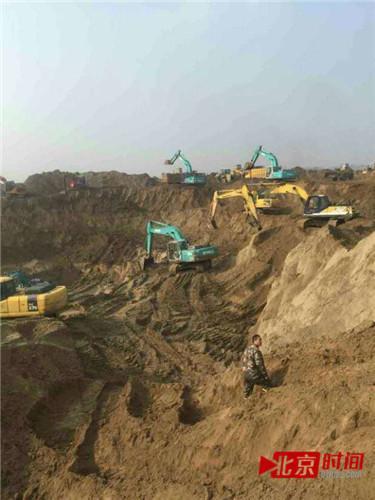 The rescue scene (rescue workers)
The rescue scene (rescue workers)After the incident, have been rushed to the scene of the rescue workers reached more than 500 employees, on-site construction vehicles and machinery with its more than hundred units. Because the mouth is too narrow, restricted access for adults, taken at the well progressive to be near the bottom of the excavation rescue relief in a way.
The evening of November 9, rescue work had been advanced to the downhole sand. But it was only 1 m and complex geological conditions at the wellhead, so rescue very difficult. Rescuers took many methods to detect, failed to recognize the signs of a child. When discovery cannot be determined. As of today at noon, rescuers still could not find the children's trail.
User question: why aid is so slow
According to media reports, the scene, the hole depth exceeds 30 metres, digging more than 200,000 cubic meters of earthwork. Several excavators of the site, average time poach 1.5 cubic meters. So 4 days, dozens of the excavator driver, has been operating in rotation to keep "people have machines do not rest." Meanwhile, rescuers have been down oxygen.
Faced with such a large scale rescue, long time, one time, equipment and programs to rescue raises questions.
Question 1: why "er" still no kids?
Judging from the rescue, after 90 hours of digging, rescuers have dug into the sand but still no children in sight.
Green boat captains mountain rescue team of mentougou units, have participated in building collapse rescue (USAR) training, and participated in a similar rescue operations. He told the "Beijing" (ID:btime007) boys are likely to fall into the bottom of the "sand".
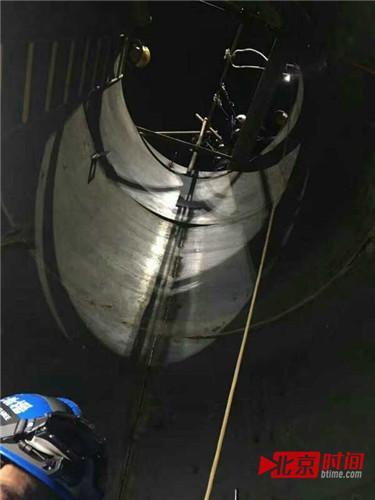 The rescue scene (rescue workers)
The rescue scene (rescue workers)Mountain introduction, sand, moisture content of the sediments at the bottom of the wells, the load-carrying capacity is weak, people above get caught just like on the Moor. So even if digging down to the so-called "sandy bottom", nor to see the child's exact location.
Mountain called "Sgt", if the children really got into the "sand", the subsequent mining rescue is still down, but will usually take the form of digging to avoid mechanical touch and hurt children in mining.
Question 2: construction machinery for rescue capital is, why is there no professional equipment?
People say, user referred to "life detector", "sonar", "radar" and other equipment, are used to find those trapped. It was his understanding that, in the course of the rescue, had used the instrument to detect the location and condition of the boy, but had no clue.
He explained that in deep relief, there is a professional device called "deep relief". Deep rescue can rescue personnel on the ground operations, by a rope down to the location of the trapped, with the head of the lasso tools such as fixed those trapped, pull it back into the ground, but the use of such equipment on the premise that knows the exact location of those trapped.
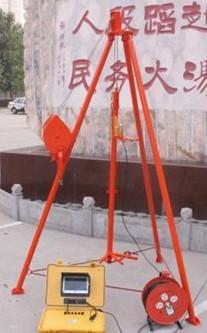 Deep rescue (online screenshot)
Deep rescue (online screenshot)Internet users called "radar, sonar" is a kind of life detector, is often used in the earthquake relief, "if they really fall into the" sand ", the body was wrapped in sediment, detector is difficult to play a role. "People say, in addition, at the bottom of low visibility situations, video devices cannot see the child's image.
Question 3: dig the pit is the only way?
Mountain called "Sgt", at present, the prevailing deep relief there are 5 programmes at home and abroad. First, means the rope, guiding those trapped themselves. But from the case in recent years, trapped for children, its lack of power. But also injuries and remained in a coma, to save themselves.
Second, the rescue workers tied with ropes are inverted postures in the well, the ropes tied to the stranded people, lift it out of the ground. But rescuers handstand position, likely to cause congestion in the head, plus the lack of air, if not quickly rescued, rescue personnel likely to cause fainting.
The third method, it is next to the deep rely on manual or machine and then a larger diameter hole shaft reaches trapped depth, horizontal digging channels, break the wall, rescued those trapped. This method requires high field geological conditions, loose soil, easily lead to collapse, a threat to those trapped, rescue workers.
Fourth is the use of deep relief.
But these methods are where you want to clear the trapped people and bodies, so, the rescue could only take the fifth, which is digging a hole driving way.
Question 4: rescue time for so long?
Blue rescue team in Beijing Meng Xiang road, "Sgt" introduced, in order to ensure the safety of deep, usually to do 1:1 to 1:1.5, or the risk of collapse. That is, if the pit up to 30 m, so the pits in the surface radius is 30 to 45 meters. This is the theoretical value, if the bad geological conditions, or large machinery to join this width be increased.
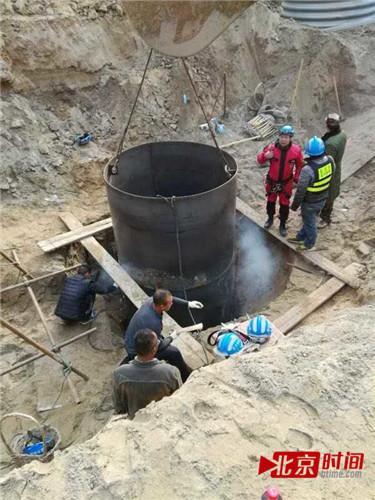 To prevent collapse and rescue workers place the protection casing (rescuers)
To prevent collapse and rescue workers place the protection casing (rescuers)Therefore, in this rescue, construction machinery not only to dig down, but also continue to spread around. So, even if there is so much construction machinery, dig under the to more than 90 hours over more than 30 meters. Meanwhile, in order to prevent borehole collapse, also placed protection casing to protect it.
During the rescue, big pit mining has close to 200 meters in diameter, but the soil is loose, the scene still cracks the ground occurs multiple times. In order to prevent collapse, rescue operations had to be suspended, which also affects the speed of rescue.
Question 5: rescuers are professional?
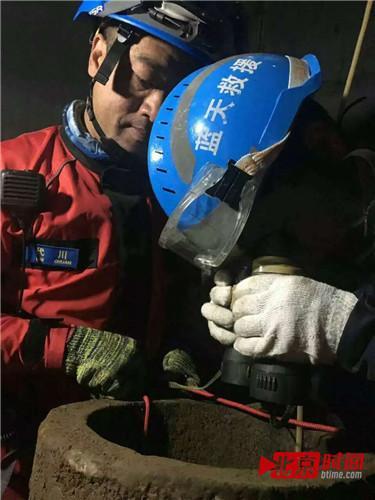 Rescue workers to the observation of (aid workers)
Rescue workers to the observation of (aid workers)People said, compared with other types of rescue operations, deep relief is not high technology content, in addition to deep relief, without any special equipment, fire departments, rescue experience civil rescue team is capable of. But because the space is small, constrained by complex factors such as geological and geomorphological conditions, so rescue very difficult.
Mountaineer introduced, specifically for mine rescue team, tunnel or cave rescue, but crashed into the deep well of very low probability of occurrence, and does not require special techniques and equipment. At present there is not a team specializing in such rescue operations.
Author: Fan Botao
Responsible editor: Zhang Xiaoya
Article keywords:Rescuers boy deep
I want feedback
Save a Web page
Beijing time
河北男童坠入井底 为何救援90小时仍无踪影|救援人员|男童|深井_新闻资讯
原标题:河北男童坠井 为何救援90小时仍无踪影?
11月6日上午11时,河北保定蠡县一6岁男童不慎落入一口40余米深的枯井之中。截止10日中午,救援行动已经持续了90多个小时,但仍未能发现男童的踪影。
救援为何如此缓慢?除了挖坑为何不用专业设备?有网友对救援行动提出了疑问。对此,曾参与过此类救援的专业人士山民向“北京时间”(ID:btime007)表示,从目前情况来看,男童很可能陷入了井底的“积沙”中,这使救援工具派不上用场,并且增加了救援难度。
男童坠井90小时500人搜救仍无消息
11月6日11时许,河北保定蠡县中孟尝村一6岁男童跟随父亲在田间收菜时,不慎坠入一口枯井中。
据 媒体报道,这口枯井是一口废弃的灌溉机井。井口宽度约30厘米,稍稍高于地面,井深超过40米。在当地田间,这样的枯井隔不远就会有一座。当井内枯水后, 村民会将灌溉喷头挪去其他新打的机井继续使用,因而废井口呈敞开状态,通常也不会加盖或设置警示标示。由此,男孩才会不慎坠入井下。
 救援现场(救援人员供图)
救援现场(救援人员供图) 事发后,陆续赶往事发现场的救援人员达到500余人,现场施工作业的车辆、机械也超过百台。由于井口过于狭窄,成年人难以进入,遂采取了在井边开挖破拆逐步向井底靠近的方式进行救援。
11月9日傍晚,救援工作已经推进到了井下的沙层。但该处井口只有1米且地质情况复杂,因此救援难度很大。救援人员采取多种方法进行探测,仍未能发现孩子的迹象。何时能发现尚无法确定。而截至今日中午,救援人员仍然没能发现孩子的踪迹。
网友疑问:救援为何如此缓慢
据媒体报道,救援现场的大坑深度超过30米,挖掘的土方量超过20万立方米。而现场的多部挖掘机,平均每次只能挖走1.5立方。因此,4天来,数十位赶来的挖掘机司机师傅,一直在轮换作业,以保持“人歇机器不歇”。同时,救援人员也在不断向下输氧。
而面对如此大的救援规模,漫长的救援时间,有网友对救援的时长、设备和方案提出了疑问。
疑问1:为何“到底儿”仍不见孩子?
从现场救援情况来看,经过90个小时的挖掘,救援人员已经挖到了沙土层却仍不见孩子踪影。
绿舟救援队门头沟分队队长山民,曾参加过建筑物坍塌救援(USAR)培训,并参与过类似救援行动。他告诉“北京时间”(ID:btime007)男童很可能陷入了井底的“积沙”中。
 救援现场(救援人员供图)
救援现场(救援人员供图) 山民介绍,水井底部的泥沙、沉积物含水量大,承重能力很弱,人落在上面就像踩在沼泽地上一样会陷进去。因此,即便下挖到了所谓“沙土井底”,也无法看到孩子的具体位置。
山民告诉“北京时间”,如果孩子真的陷入了“积沙”中,后续的救援仍然是向下挖掘,但通常会采取人工挖掘的方式进行,以免大型机械在挖掘时触碰并伤到孩子。
疑问2:救援主力都是施工机械,为何不见专业设备?
山民表示,网友所提到的“生命探测仪”、“声呐”、“雷达”等设备,都是用于发现受困者的。据他了解,在此次救援过程中,曾使用仪器对男童的位置和状况进行探测,但没有任何线索。
他介绍,在深井救援中,有一种专业设备叫“深井救援器”。深井救援器可以由救援人员在地面操作,由绳索下放至受困者所在位置,用装在头部的套索等工具固定受困者,将其拉回地面,但使用这种设备的前提是知道受困者确切的位置。
 深井救援器(网络截图)
深井救援器(网络截图) 网友所称的“雷达、声呐”,是生命探测仪的一种,在地震救援中会经常使用,“如果孩子真的陷入“积沙”中,身体被泥沙包裹,探测仪很难发挥作用。”山民说,此外,在井底能见度很低的情况下,视频设备也无法看到孩子的影像。
疑问3:挖大坑是唯一的方法么?
山民告诉“北京时间”,目前,国内外通行的深井救援有5种方案。其一,就是下放绳索,指导受困者自救。但从近几年来发生的坠井案例来看,受困者多为儿童,其力量不足。而且还可能受伤或处在昏迷状态,难以自救。
其二,救援人员绑着绳索呈倒立姿势进入井内,将绳索绑在受困者身上,将其拉出地面。但救援人员倒立姿势时,容易造成头部充血,加上井内空气不足,如果不能快速完成营救,救援人员自身容易造成昏厥。
第三种方法,则是在深井的旁边依靠人工或机械再打出一口直径较大的竖井,到达受困者深度后,再横向挖掘通道,打破井壁,把受困者救出。这种方法对现场地质条件要求较高,如果土质疏松,容易造成坍塌,对受困者、救援人员都有威胁。
第四种则是使用深井救援器。
但这几种方法都需要明确受困人的位置和身体状况,所以,此次救援只能采取第五种,也就是挖坑掘进的方式进行。
疑问4:救援时间为何这么长?
北 京蓝天救援队队员孟祥路向“北京时间”介绍,为了保障深挖的安全,通常要做1:1到1:1.5的放坡,否则就有坍塌的风险。也就是说,如果坑深达到30米,那么这个坑在地表的半径就要达到30至45米。而这还是理论上的数值,如果地质条件不好,或者有大型机械加入,这个宽度还要增加。
 为防止坍塌救援人员放置护壁套管(救援人员供图)
为防止坍塌救援人员放置护壁套管(救援人员供图) 因此,在此次救援中,工程机械不仅要向下挖掘,还要不断的向四周扩。所以,即便有这么多的施工机械,90多个小时过去了才下挖了30多米。同时,为了防止井壁发生坍塌,还要放置护壁套管加以保护。
在此次救援中,挖掘的大坑直径已接近200米,但当地土质疏松,现场仍然多次出现地面裂痕。为了防止坍塌发生,救援行动不得不暂停,这也影响了救援的速度。
疑问5:救援人员是否专业?
 救援人员向井内观察(救援人员供图)
救援人员向井内观察(救援人员供图) 山民表示,与其他类型的救援行动相比,深井救援的技术含量并不算高,除了深井救援器,没有什么特殊的装备,消防部门、有救援经验的民间救援队是可以胜任的。但因为空间狭小,受制于地质地貌条件等复杂因素,所以救援难度很大。
山民介绍,有救援队专门针对矿井、隧道甚至溶洞救援,但坠入深井的事发概率很低,又不需要特殊的技术和装备。目前国内还没有一支队伍专门负责这类救援行动。
作者:范博韬
责任编辑:张小雅
文章关键词: 救援人员 男童 深井
我要反馈
保存网页
北京时间